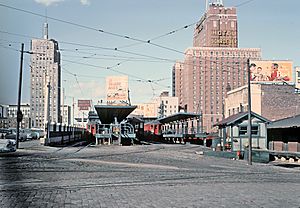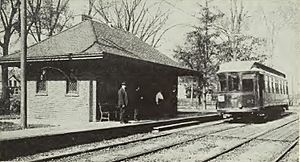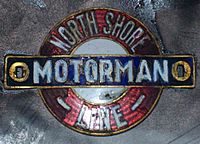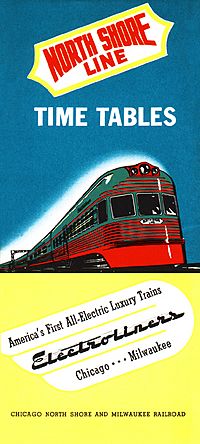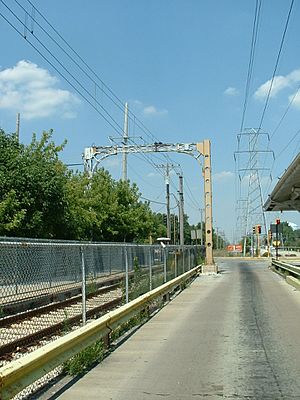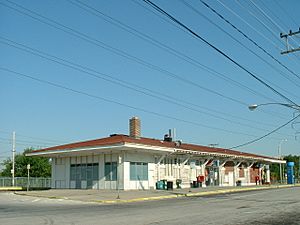Chicago North Shore and Milwaukee Railroad facts for kids
 |
|

Cincinnati car 700 near Green Bay Junction in Lake Bluff circa 1958.
|
|
| Overview | |
|---|---|
| Headquarters | Highwood, Illinois |
| Reporting mark | CNSM |
| Locale | Illinois and Wisconsin |
| Dates of operation | July 16, 1916–January 21, 1963 |
| Predecessor | Chicago and Milwaukee Electric Railroad |
| Technical | |
| Track gauge | 4 ft 8 1⁄2 in (1,435 mm) standard gauge |
| Electrification |
|
| Length | In 1954:
|
The Chicago North Shore and Milwaukee Railroad (also called the North Shore Line) was a special type of interurban railroad. It carried both people and goods. Its main route was about 88.9 miles (143.1 km) long. It connected the Chicago Loop to downtown Milwaukee. There was also a shorter 8.6 miles (13.8 km) branch line between Lake Bluff and Mundelein, Illinois. The North Shore Line also ran streetcars, city buses, and motor coaches.
This railroad was greatly improved by its owner, Samuel Insull. It was known for its fast trains and strong tracks. It also had new ideas like "ferry truck" services. Its streamlined Electroliner trains were very famous. A railroad expert named William D. Middleton called the North Shore Line a "super interurban." He said its closing marked the end of the "interurban era" in the United States.
Since 1964, the Yellow Line of the Chicago Transit Authority (CTA) has used a small part of the old North Shore Line tracks. This section runs from Chicago to Skokie, Illinois. Some of the North Shore Line's old trains are now kept in railroad museums. The old Dempster Street Station is even listed as a historic place.
Contents
What was the North Shore Line's route?
The North Shore Line had several important routes. These included main lines for long-distance travel and shorter city lines.
Main Interurban Lines
The North Shore Line had four main routes that connected different cities.
Shore Line Route (Chicago Division)
This main line ran for 19.4 miles (31.2 km) through the North Shore area. It went from Linden Avenue in Wilmette to North Chicago Junction. It ran next to Sheridan Road. This route was mostly double-tracked, meaning it had two sets of tracks. Power came from overhead wires. In the late 1930s, parts of this line were rebuilt to be safer and faster. Passenger service on this route stopped in 1955. After that, it was mainly used for freight.
Skokie Valley Route (Skokie Division)
This was a faster, 25 miles (40 km) main line. It went through the Skokie River valley from Howard Street in Chicago to North Chicago Junction. It ran next to U.S. Route 41. This route was built between 1923 and 1926. Its purpose was to let fast, limited-stop trains avoid busy areas. It was entirely double-tracked and had its own private path. Power came from both a third rail and overhead wires. From 1925 to 1948, the Chicago Rapid Transit Company (and later the CTA) ran local trains on part of this route.
Milwaukee Division
This main line was 48.2 miles (77.6 km) long. It stretched from North Chicago Junction to Harrison Avenue in Milwaukee. It served cities like Waukegan, Zion, Kenosha, and Racine. Most of this line had two tracks and its own private path. It used a mix of overhead wires for power.
Libertyville Division
This was a branch line about 8.6 miles (13.8 km) long. It ran from Lake Bluff to Mundelein. It connected to the Shore Line Route and the Skokie Valley Route. This line was mostly double-tracked. It was used for both passengers and freight.
City Lines
The North Shore Line also operated local streetcar services in some cities.
Waukegan–North Chicago
The North Shore Line ran electric streetcars in Waukegan and North Chicago. There were two main lines: the North Avenue Line and the Washington Street Line. These lines were mostly on city streets. They helped people travel within the cities. After 1947, the streetcar service here was replaced by buses.
Milwaukee
The North Shore Line had a streetcar line in Milwaukee. It ran for 3.46 miles (5.57 km) from Harrison Avenue to downtown Milwaukee. This line was entirely double-tracked and ran on city streets. It helped connect the interurban trains to the heart of Milwaukee. This streetcar service stopped in 1951.
Chicago "L" Connections
The North Shore Line used parts of Chicago's elevated train system, known as the "L." This allowed its trains to go directly into Chicago.
Evanston Line
Shore Line Route trains used the 4 miles (6.4 km) Evanston Line of the Chicago "L." This ran from Linden Avenue in Wilmette to Howard Street in Chicago. Power came from overhead wires. When the North Shore Line took over in 1916, trains only went as far as Church Street in Evanston. Later, in 1919, direct service into Chicago began. This service stopped in 1955.
Howard Street–Roosevelt Road
In 1919, the North Shore Line made an agreement to use the "L" tracks. This allowed its trains to go directly into Chicago. They traveled 12 miles (19 km) from Howard Street to Roosevelt Road. North Shore Line trains usually used the faster express tracks. Power mostly came from a third rail. Trains made limited stops at several stations, including Wilson Avenue and Belmont Avenue. South of the Merchandise Mart, trains went around the Loop. This direct service into Chicago continued until the railroad closed in 1963.
South Side Extension
In 1922, another agreement allowed some North Shore Line trains to go even further south. They could use the South Side Elevated from Roosevelt Road to the 63rd/Dorchester station. This gave the North Shore Line access to the "L" train yards. However, service south of Roosevelt Road stopped in 1938.
What is the North Shore Line's history?
The North Shore Line has a long and interesting history, starting in the late 1800s.
Early Days
The Bluff City Electric Street Railway Company started in May 1895 in Waukegan, Illinois. It was a local streetcar line. In 1898, the Chicago and Milwaukee Electric Railroad bought it. By 1899, trains ran from Waukegan to Church Street in Evanston. Passengers could then switch to other trains to go into Chicago. Over the next ten years, the line was improved. It got a second track and moved off public roads.
Between 1902 and 1904, a branch line was built from Lake Bluff to Libertyville. This line was extended to Mundelein in 1905. It helped the railroad carry freight, especially from a large gravel pit. It also allowed freight to be exchanged with other railroads.
In 1904, the Chicago and Milwaukee Electric started buying land to extend its service into Wisconsin. By December 1905, trains reached Kenosha, Wisconsin. They reached Racine in September 1906. Even though the company faced financial problems in 1907, construction continued. The northern extension was finished in 1908. Direct service between Evanston and Milwaukee began that October.
Even with financial troubles, more people used the railroad. This allowed for more improvements. Bridges were upgraded, and the main line was fixed. New trains were bought, including modern steel passenger cars in 1915. The idea of going directly into Chicago without transfers was also studied. This would make the interurban more competitive with steam railroads.
The Insull Years
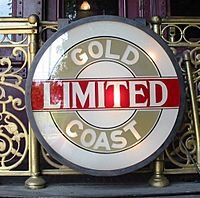
When the North Shore Line took over in 1916, its trains went to Church Street in Evanston. Passengers had to transfer to other trains to get to Chicago. In 1919, new agreements allowed North Shore Line trains to go directly into Chicago. They used the "L" tracks through the Loop to a station at Roosevelt Road. In 1920, a new station opened in Milwaukee. Over the next few years, almost all single-track sections in Wisconsin were made into double tracks.
In the early 1920s, the railroad started running special, limited-stop trains. Some even had fancy dining and lounge cars. One famous train was the Gold Coast Limited, which started in 1917. The North Shore Line also created bus routes. These buses brought passengers from areas not directly served by the trains.
Building the Skokie Valley Route
As the towns along the North Shore grew, the railroad got more passengers. But the busy city centers made it hard for trains to go fast. The North Shore Line wanted to compete with other railroads for longer trips, especially between Chicago and Milwaukee. So, they decided to build a new, faster route through the Skokie Valley. This area was mostly empty farmland at the time.
Land was bought and money was raised in 1923 and 1924. Construction of the new line began in April 1924. This new line started near the Howard Street "L" station. It went west into Niles Center (now Skokie) and then north through marshy land. It ran next to another railway line. At South Upton, the new route connected to the North Shore's Mundelein branch. From there, a new connection went north to the original main line.
An agreement was made with the Chicago Rapid Transit Company. Local "L" train service started on the new line to the Dempster Street station in Niles Center in 1925. People hoped this new "L" line would cause a building boom, but the Great Depression slowed growth. Skokie didn't really grow a lot until the 1950s.
Even though the Niles Center "L" service didn't become very popular, the transit company benefited. New train maintenance shops were built along the Skokie Valley line. These large shops helped the "L" system and are still used today by the Chicago Transit Authority.
The rest of the North Shore Line's new Skokie Valley line opened in 1926. This new route had 18 miles (29 km) of new double-track railroad. It was only 2.5 miles (4.0 km) longer than the old main line. Because it went through rural areas, trains could go much faster. The Mundelein branch was also improved with a new station and two tracks. With the new Skokie Valley line, the North Shore started hourly local service between Chicago and Mundelein. This was mixed with hourly limited-stop trains between Chicago and Milwaukee. Using the Skokie Valley line cut travel time by 20 minutes.
The original main line, now called the Shore Line, continued to serve Chicago-Waukegan. It had both limited-stop and local services.
The Great Depression
After the stock market crash in 1929, things seemed normal at first. But as the Great Depression got worse, the railroad faced serious problems. It went into receivership in 1932. The bad economy and high unemployment caused fewer people to ride trains, so the railroad lost money. A worker strike in 1938, caused by a 15% pay cut, stopped the railroad for seven weeks.
Even during these tough times, the North Shore was able to do a big project. It separated its tracks from roads in some areas. This made it safer and cheaper to operate. The government's Public Works Administration program helped fund this project in 1937. This project was complicated because trains still had to run during construction. It was finished in late 1941 and cost $4.3 million.
Modern Trains: Green Liners and Electroliners
To compete with new, fast trains on other railroads, the North Shore Line updated its passenger cars in 1939. About 15 older cars were completely modernized. They got new heating, ventilation, floors, and interiors. Their outsides were painted green, gray, and red. These cars were called "Greenliners." They were used for fast service on the Skokie Valley line.
The most important part of the update was buying two new articulated streamlined trains. These trains had four cars linked together. They were called Electroliners. They were the railroad's best service and could go as fast as 90 mph. The Electroliners started service on February 9, 1941. Each train ran five trips between Chicago and Milwaukee every day. The Electroliners continued to run until the railroad closed in 1963. They were then sold to another company and used until 1979.
War and Decline
During World War II, railroads in the United States saw a huge increase in traffic. The North Shore Line's freight and passenger numbers reached record levels. This was partly because it served important military bases like Fort Sheridan and the Great Lakes Naval Training Station. The North Shore Line was so busy that it had to borrow trains from other companies.
The money earned during the war was enough to help the railroad pay off some debt. After the war, a new company took over in 1946.
In 1948, a wage dispute led to a 91-day strike. The strike ended with higher fares and wages. At the same time, fewer people started traveling by train as more cars became available. These problems caused the North Shore Line to lose a lot of money. In 1949, the railroad tried to cut some services that weren't making money. Dining car service (except on the Electroliners) was stopped. Service on the Shore Line was reduced. The railroad even tried to stop Shore Line service completely, but it was not allowed.
The streetcar service in Waukegan ended in 1947. The company replaced it with buses. The streetcar service in Milwaukee stopped in 1951.
In 1953, the railroad sold some of its tracks between Chicago and Wilmette to the CTA. The Shore Line continued to operate on these tracks.
The railroad tried again to stop Shore Line service in 1954. Even though rush hour traffic was still good, off-peak ridership had dropped a lot. The many stops and street running on this route made it slow. Travel time on the Shore Line was twice as long as on the Skokie Valley route. The new Edens Expressway also caused more people to stop using the train. Despite strong opposition, the railroad was allowed to end service on the Shore Line. The last day of service was July 24, 1955. A small part of the line was kept for freight and access to the railroad's shops. The rest of the line was removed. Much of the old path became parking for people who switched to other trains.
End of Rail Service
The company that owned the North Shore Line wanted to stop losing money. In 1958, the railroad asked to stop all service and close down. The government agency in charge recommended closing it. But Illinois regulators wanted the railroad to keep running. For a while, ridership stayed steady. But when the Northwest Expressway opened in late 1960, connecting to the Edens Expressway, the North Shore Line lost many passengers. It was losing 46,000 passengers each month.
The Chicago Transit Authority looked into keeping some train service between Waukegan and Chicago. They thought buses could take over between Lake Bluff and Mundelein. A report in October showed that only about 14,000 people rode the train daily. The line also needed many updates. The CTA said it would only take over if it didn't cost them money and if they got help to operate it. In February 1961, a new study showed even fewer passengers. No action was taken because the conditions could not be met.
In February, the railroad asked for a quick decision on its request to close. It said it was losing too much money. On May 17, 1962, the request was approved. This meant the railroad could close if no buyer came forward in 35 days. Both Illinois regulators and a group of commuters were against it. The commuters offered to buy the railroad, but they couldn't raise enough money. In November, Illinois agreed with the government's decision. The last full day of service was January 20, 1963. The final trains reached their destinations early the next morning. Some freight trains ran for another week to collect remaining cars.
After the Closing
Most of the tracks were removed in the next two years. The Chicago Transit Authority bought the southernmost part of the Skokie Valley line. This was the section between Howard Street and Dempster Street, Skokie. In 1964, they got government money for a successful transportation project. They called the new non-stop service the "Skokie Swift." That same year, a group of towns tried to bring back train service further north. But this was stopped because another railroad bought the tracks between Dempster Street and Lake-Cook Road for freight.
Today, Amtrak's Hiawatha Service runs trains between Chicago and Milwaukee. Metra commuter trains also serve areas like Kenosha, Libertyville, and Mundelein.
Much of the old North Shore Line path from Illinois to Milwaukee was sold off. In some places, parts of the old path have been turned into walking and biking trails. One example is the Green Bay Trail.
Preservation

One of the famous Electroliner trains (number 801–802) is kept at the Illinois Railway Museum in Union, Illinois. This museum also has 15 other passenger and freight cars from the North Shore Line. Both Electroliner trains were used by another company from 1964 to 1980 before being retired. The other Electroliner set (803–804) is stored at the Rockhill Trolley Museum in Pennsylvania.
Other museums that have North Shore Line cars include the Fox River Trolley Museum in Illinois, the East Troy Electric Railroad Museum in Wisconsin, the Shore Line Trolley Museum in Connecticut, and the Seashore Trolley Museum in Maine.
The Dempster station has been saved, though it was moved. The Briargate and Kenosha stations also still exist and are used for businesses.
Some old, unused sections of track can still be found between Dempster Street and Lake Cook Road.


